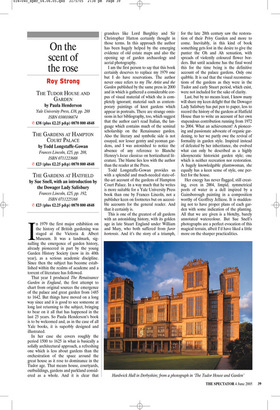On the scent of the rose
Roy Strong
THE TUDOR HOUSE AND GARDEN by Paula Henderson Yale University Press, £38, pp. 288 ISBN 0300106874 ✆ £38 (plus £2.25 p&p) 0870 800 4848 THE GARDENS AT HAMPTON COURT PALACE by Todd Longstaffe-Gowan Frances Lincoln, £25, pp. 208, ISBN 0711223688 ✆ £23 (plus £2.25 p&p) 0870 800 4848 THE GARDENS AT HATFIELD by Sue Snell, with an introduction by the Dowager Lady Salisbury Frances Lincoln, £25, pp. 192, ISBN 0711225168 ✆ £23 (plus £2.25 p&p) 0870 800 4848 In 1979 the first major exhibition on the history of British gardening was staged at the Victoria & Albert Museum. It was a landmark, signalling the emergence of garden history, already pioneered in part by the young Garden History Society (now in its 40th year), as a serious academic discipline. Since then the subject has become established within the realms of academe and a torrent of literature has followed.
That year I produced The Renaissance Garden in England, the first attempt to chart from original sources the emergence of the palace and great garden from 1485 to 1642. But things have moved on a long way since and it is good to see someone at long last returning to the subject, bringing to bear on it all that has happened in the last 25 years. So Paula Henderson’s book is to be welcomed and, as in the case of all Yale books, it is superbly designed and illustrated.
In her case she covers roughly the period 1500 to 1625 in what is basically a solidly architectural approach, a refreshing one which is less about gardens than the orchestration of the space around the great house as it rose to dominance in the Tudor age. That means house, courtyards, outbuildings, gardens and parkland considered as a whole. And it is clear that grandees like Lord Burghley and Sir Christopher Hatton certainly thought in those terms. In this approach the author has been hugely helped by the emerging evidence of old estate maps and also the opening up of garden archaeology and aerial photography.
I am the first person to say that this book certainly deserves to replace my 1979 one but I do have reservations. The author never once refers to my The Artist and the Garden published by the same press in 2000 and in which is gathered a considerable corpus of visual material of which she is completely ignorant; material such as contemporary paintings of knot gardens which appear in portraits. There are strange omissions in her bibliography, too, which suggest that the author can’t read Italian, the language which contains much of the seminal scholarship on the Renaissance garden. Also the literary and symbolic side is not essayed, nor lesser gentry and yeoman gardens, and I was astonished to notice the absence of any reference to Blanche Henrey’s locus classicus on horticultural literature. The blame lies less with the author than the reader at the Press.
Todd Longstaffe-Gowan provides us with a splendid and much-needed state-ofthe-art account of the gardens of Hampton Court Palace. In a way much that he writes is more suitable for a Yale University Press book than one by Frances Lincoln, not a publisher keen on footnotes but on accessible accounts for the general reader. And that it certainly is.
This is one of the greatest of all gardens with an astonishing history, with its golden age in late Stuart England under William and Mary, who both suffered from furor hortensis. And it’s the story of a triumph, for the late 20th century saw the restoration of their Privy Garden and more to come. Inevitably, in this kind of book something gets lost in the desire to give the punter the Oh and Ah sensation, with spreads of violently coloured flower borders. But until academe has the final word this for the time being is the definitive account of the palace gardens. Only one quibble. It is sad that the visual reconstructions of the gardens as they were in the Tudor and early Stuart period, which exist, were not included for the sake of clarity.
Last, but by no means least, I know many will share my keen delight that the Dowager Lady Salisbury has put pen to paper, less to record the history of the gardens at Hatfield House than to write an account of her own stupendous contribution running from 1972 to 2004. What an achievement! A pioneering and passionate advocate of organic gardening, to her we partly owe the revival of formality in garden style. Inspired instead of defeated by her inheritance, she evolved what can only be described as a highly idiosyncratic historicist garden style; one which is neither recreation nor restoration. A hugely knowledgable plantswoman, she equally has a keen sense of style, one perfect for the house.
Her energy has never flagged, still creating, even in 2004, limpid, symmetrical pools of water in a dell inspired by a Gainsborough painting in a composition worthy of Geoffrey Jellicoe. It is maddening not to have proper plans of each garden with some indication of the planting. All that we are given is a blotchy, barely annotated watercolour. But Sue Snell’s photographs are a perfect evocation of this magical terrain, albeit I’d have liked a little more on the sharper practicalities.


















































 Previous page
Previous page